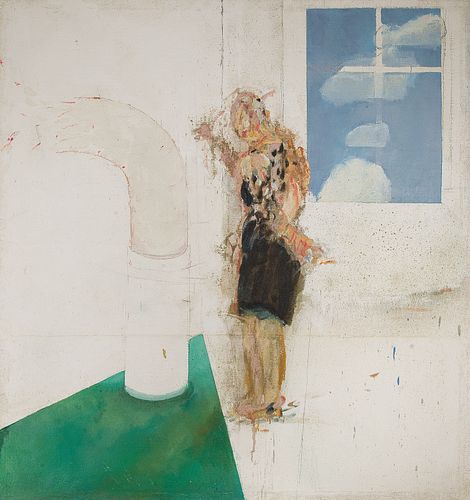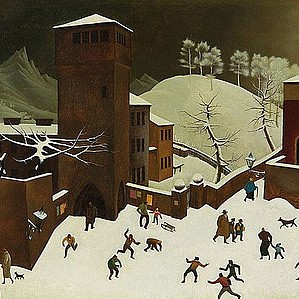ANSELM KIEFER (born 1945 in Donaueschingen) Standing Figure, around 1968
Lot 247
Categories
Estimate:
EUR€100,000 - EUR€150,000
$104,166.67 - $156,250
Absentee vs Live bid
Two ways to bid:
- Leave a max absentee bid and the platform will bid on your behalf up to your maximum bid during the live auction.
- Bid live during the auction and your bids will be submitted real-time to the auctioneer.
Bid Increments
| Price | Bid Increment |
|---|---|
| EUR€0 | EUR€10 |
| EUR€100 | EUR€50 |
| EUR€700 | EUR€100 |
| EUR€1,000 | EUR€200 |
| EUR€3,000 | EUR€300 |
| EUR€3,600 | EUR€400 |
| EUR€4,000 | EUR€500 |
| EUR€7,000 | EUR€1,000 |
| EUR€16,000 | EUR€2,000 |
| EUR€30,000 | EUR€3,000 |
| EUR€36,000 | EUR€4,000 |
| EUR€40,000 | EUR€5,000 |
About Auction
By Widder Auctions
May 19, 2022
Set Reminder
2022-05-19 11:00:00
2022-05-19 11:00:00
America/New_York
Bidsquare
Bidsquare : Masterpieces
https://www.bidsquare.com/auctions/widder-auctions/masterpieces-9287
Masterpieces of classical modernism by Austrian and international artists coming up for auction in Vienna on May 19th Widder Auctions office@widderauktionen.com
Masterpieces of classical modernism by Austrian and international artists coming up for auction in Vienna on May 19th Widder Auctions office@widderauktionen.com
- Lot Description
ANSELM KIEFER*
(born 1945 in Donaueschingen)
Standing Figure, around 1968
oil/jute, 164,5 x 155 cm
Provenance: acquired from the artist, private collection Germany, auction house Koller Munich 2008, international private collection
ESTIMATE °€ 100.000 - 150.000
German and Austrian painter, sculptor and installation artist of the 20th century and contemporary art. Counts among the most important artists of the present, representative of Neo-Expressionism and New Figuration. Studied from 1966 to 1968 with Peter Dreher in Freiburg, then with Horst Antes in Karlsruhe and with conceptual artist Joseph Beuys in Düsseldorf. Influenced by Georg Baselitz and Jörg Immendorf. Monumental works, interest in materiality, combining pigments and organic materials, ash, glass, wood, sand, clay, seeds, twigs, wire, lead and textiles. Large-scale works and installations on the themes of mythology, transience, memory, forgetting and remembering in relation to National Socialism. Visual examination of German history, picks up symbols, motifs and themes of political and cultural tradition such as the Hitler salute, among others, in the series Heroic Symbols.
Anselm Kiefer, from Donaueschingen in Baden-Württemberg, is one of the best-known and most successful German and Austrian artists after the Second World War - in 2018 he also received Austrian citizenship. His works have been presented at the most important international art exhibitions – documenta 6, 7 and 8, Venice Biennale (German Pavilion 1980); – and exhibited in many museums in Europe, Japan and the United States of America. Kiefer has received numerous awards and honors. In 1965, Kiefer began studying law and Romance studies in Freiburg im Breisgau, which he did not complete. During this time he also devoted himself to the fine arts and studied painting in Freiburg with Peter Dreher from 1966 to 1968 and then as a student of Horst Antes in Karlsruhe. In the present work, Anselm Kiefer, who works with a wide variety of materials, techniques and artistic genres, appears as a painter. The picture was taken in the year of his first solo exhibition "Besetzen", which took place in 1969 as a series of black-and-white photographs of his controversial Karlsruhe thesis, an extensive performance on National Socialism. In this performance, Kiefer performed the fascist or "German" salute at various locations in Europe (Switzerland, Holland, France, Italy), with which he "conceptually simulates identification with the perpetrators". Especially in his early years, Kiefer worked intensively on German history. How different is our painting! A barefoot young woman in a short, black dress is shown here, her form expressively dissolved - the always political jaw, which in view of his literally leaden works full of mysticism and historical quotations, especially in his own country, was called "Teutonic Expressionism", even "Brutalism" (FAZ dated April 11, 1984) was accused of being a painter of erotic fantasies? The thought is by no means absurd: in 1969, after all, Kiefer wrote the book “Die Frauen” and in 1988 the book “Eroticism in the Far East or: transition from cool to warm”. Similar to Anselm Kiefer's well-known, large-format oil painting "Red Woman" from 1967, we encounter the "standing figure" in our painting in a strictly constructed spatial studio context. The curved pipe, the deeper meaning of which one can figure out for oneself, appears like a specially placed prop of an interior study; the conspicuous green corner on the floor, which defines an image axis diagonally from the bottom left across the figure to the window at the top right, is another essential construction element set according to aesthetic principles, which subtly defines the pictorial space with floor, wall and pipe. The woman turns away from the voyeuristic viewer, wrests the reins of action from him and becomes an actor herself by tampering with the wall in the corner of the room in an unspecified way. She seems more cheeky scribbling on the wall than imitating Kiefer's scandalous "German greeting".
Please note: in a correspondence between the current owner and the artist, Kiefer confirms the authenticity of the work. As it is a juvenile painting, Anselm Kiefer will not include the work in the catalogue raisonné.
PLEASE NOTE:
The purchase price consists of the highest bid plus the buyer's premium, sales tax and, if applicable, the fee of artists resale rights. In the case of normal taxation (marked ° in the catalog), a premium of 24% is added to the highest bid. The mandatory sales tax of 13% is added to the sum of the highest bid and the buyer's premium. The buyer's premium amounts to 28% in case of differential taxation. The sales tax is included in the differential taxation. - Shipping Info
-
Shipping
We will send you the invoice shortly after the auction. As soon as we have recieved the amount, the art can be picked up at Johannesgasse 9-13, 1010 Vienna. Please note that the buyer is responsible for pick-up and shipping of the lot.
Should you wish to ship your items, please contact: Mailboxes Email: oper@mbe-co.at Tel: 01 5128855
Please note that storage fees may apply, should the pieces not be picked up within 14 days after invoicing for domestic and 28 days for international transportation.
Our team will be happy to assist you with any further information at office@widderauktionen.com or at 0043 676 555 66 10.
-
- Buyer's Premium



 EUR
EUR CAD
CAD AUD
AUD GBP
GBP MXN
MXN HKD
HKD CNY
CNY MYR
MYR SEK
SEK SGD
SGD CHF
CHF THB
THB












